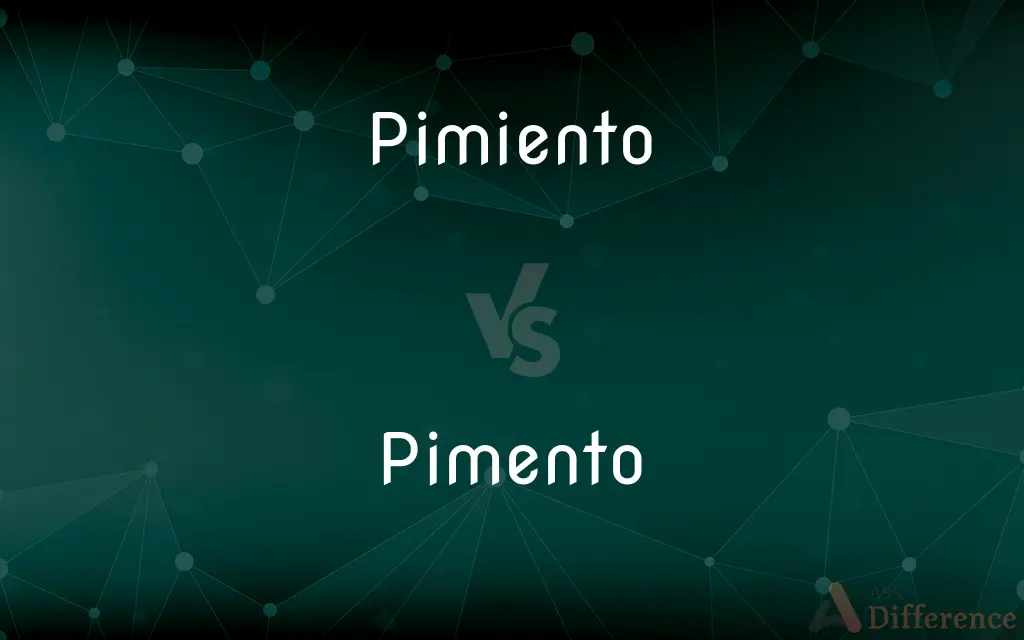Pimiento vs. Pimento — What's the Difference?
By Tayyaba Rehman & Maham Liaqat — Updated on March 25, 2024
Pimiento and pimento both refer to a variety of sweet red pepper, but "pimiento" is the Spanish spelling, while "pimento" is the English adaptation, often used interchangeably in culinary contexts.

Difference Between Pimiento and Pimento
Table of Contents
ADVERTISEMENT
Key Differences
Pimiento is the Spanish word for a type of sweet red pepper known for its heart shape and rich, sweet flavor. These peppers are small to medium in size and are commonly used in a variety of culinary dishes, ranging from Spanish cuisine to being stuffed in olives or used as a key ingredient in pimento cheese. The term "pimento" is the anglicized version of the Spanish "pimiento" and is widely used in English-speaking countries to refer to the same type of pepper. Both terms describe the same vegetable and are used interchangeably in culinary contexts, though the choice of term might vary by region or personal preference.
In cooking, pimientos are celebrated for their versatility and mild sweetness. They can be roasted, grilled, chopped, and added to salads, soups, and stews, or processed into spreads and relishes. Pimento cheese, a popular spread in the southern United States, showcases the pepper's ability to add depth and flavor to dishes. Whether referred to as "pimiento" or "pimento," these peppers are a staple in kitchens around the world, prized for their distinct taste and vibrant color.
The distinction between "pimiento" and "pimento" extends beyond spelling into the realm of cultural and linguistic preference. "Pimiento" is often preferred in contexts that emphasize the Spanish origin or authenticity of the ingredient or dish, while "pimento" is more commonly found on product labels, in cookbooks, and in culinary discourse in English-speaking countries. Despite these nuances, there is no difference in the peppers themselves or their culinary applications based on the spelling of their name.
Both pimiento and pimento peppers are rich in vitamins A and C, making them not only a flavorful addition to meals but also a nutritious one. Their widespread availability in various forms—fresh, canned, and jarred—ensures that they can be incorporated into dishes year-round, adding a pop of color and sweetness to a variety of recipes.
Ultimately, whether one uses "pimiento" or "pimento" largely depends on regional language conventions and personal preference. The terms are synonymous in the culinary world, with neither spelling implying a difference in flavor, use, or quality of the pepper.
ADVERTISEMENT
Comparison Chart
Spelling Origin
Spanish
English
Culinary Use
Stuffed in olives, added to dishes for sweetness and color
Same as pimiento, including in pimento cheese
Preference
Often used in contexts emphasizing Spanish authenticity
Commonly used in English-speaking countries
Nutritional Value
Rich in vitamins A and C
Same as pimiento
Availability
Fresh, canned, jarred
Same as pimiento
Compare with Definitions
Pimiento
Spanish term for a type of mild pepper.
Pimientos are a key ingredient in traditional tapas.
Pimento
Anglicized spelling of pimiento, referring to the same sweet pepper.
Pimento cheese is a Southern favorite.
Pimiento
A sweet red pepper used in Spanish cuisine and for stuffing olives.
The recipe calls for chopped pimiento for the sauce.
Pimento
Used in English-speaking countries, especially in product labeling.
The jar was labeled as pimento stuffed olives.
Pimiento
Often roasted to enhance sweetness.
Roasted pimiento adds a smoky flavor to the dish.
Pimento
Adds sweetness and color to dishes.
Diced pimento brightened up the rice dish.
Pimiento
Rich in flavor and nutrition.
Pimientos contribute vitamins and color to meals.
Pimento
Versatile in culinary applications.
I added pimento to the stew for a hint of sweetness.
Pimiento
Can be found in various forms for culinary use.
I used jarred pimientos for the salad.
Pimento
Nutritious addition to meals.
Pimento peppers are a great source of vitamin C.
Pimiento
A pimiento (Spanish pronunciation: [piˈmjento]) or pimento is any kind of pepper. In some English speaking countries, it is mostly associated with a variety of large, red, heart-shaped chili pepper (Capsicum annuum) that measures 3 to 4 in (7 to 10 cm) long and 2 to 3 in (5 to 7 cm) wide (medium, elongate).
Pimento
Variant spelling of pimiento
Pimiento
A red sweet pepper
A casserole of devilled pimiento
Pimento
Another term for allspice (sense 2)
Pimiento
A garden pepper (Capsicum annuum) having a mild, sweet, red fruit.
Pimento
See allspice.
Pimiento
The fruit of this plant, used in cooking, in salads, and as a stuffing for green olives.
Pimento
Variant of pimiento.
Pimiento
Syn of pimento, a cultivar of Capsicum annuum.
Pimento
A red sweet pepper, a cultivar of Capsicum annuum, used to make relish, stuffed into olives, or used as spice.
Pimiento
The Spanish sweet pepper, the fruit of which is used as a vegetable, to stuff olives, etc.; also the fruit itself. Also called pimento.
Pimento
A tropical berry used to make allspice.
Pimiento
Plant bearing large mild thick-walled usually bell-shaped fruits; the principal salad peppers
Pimento
The tree on which it grows.
Pimiento
Fully ripened sweet red pepper; usually cooked
Pimento
Allspice; - applied both to the tree and its fruit. See Allspice.
Pimento
Same as pimiento.
Pimento
Plant bearing large mild thick-walled usually bell-shaped fruits; the principal salad peppers
Pimento
Fully ripened sweet red pepper; usually cooked
Common Curiosities
What dishes commonly use pimiento or pimento?
Both are used in a variety of dishes, including pimento cheese, stuffed olives, salads, and as a flavor enhancer in many recipes.
Why are there two spellings for pimiento/pimento?
"Pimiento" is the original Spanish spelling, while "pimento" is the anglicized version used in English-speaking countries.
Are pimiento and pimento the same thing?
Yes, pimiento and pimento refer to the same type of sweet red pepper, with the difference being in spelling.
How should I store pimientos/pimentos?
Fresh peppers should be stored in the refrigerator, while canned or jarred versions have a longer shelf life and should be kept in a cool, dry place.
Where can I buy pimiento or pimento peppers?
They can be found fresh in some markets, and canned or jarred in most grocery stores.
What is the best way to use pimiento/pimento in cooking?
They are versatile and can be used in a variety of ways, from being roasted and added to dishes, to being minced and mixed into spreads like pimento cheese.
Can I substitute pimento for pimiento in recipes?
Yes, since they refer to the same pepper, they can be used interchangeably in recipes.
Can pimiento/pimento peppers be eaten raw?
Yes, they can be eaten raw and are often added to salads and sandwiches for their sweet flavor and crunch.
Is there a nutritional difference between pimiento and pimento?
No, there is no nutritional difference; both terms refer to peppers that are rich in vitamins A and C.
Are pimiento peppers spicy?
No, pimiento peppers are known for their sweet flavor rather than heat.
Share Your Discovery

Previous Comparison
Apprehend vs. Comprehend
Next Comparison
Inpatriate vs. ExpatriateAuthor Spotlight
Written by
Tayyaba RehmanTayyaba Rehman is a distinguished writer, currently serving as a primary contributor to askdifference.com. As a researcher in semantics and etymology, Tayyaba's passion for the complexity of languages and their distinctions has found a perfect home on the platform. Tayyaba delves into the intricacies of language, distinguishing between commonly confused words and phrases, thereby providing clarity for readers worldwide.
Co-written by
Maham Liaqat














































